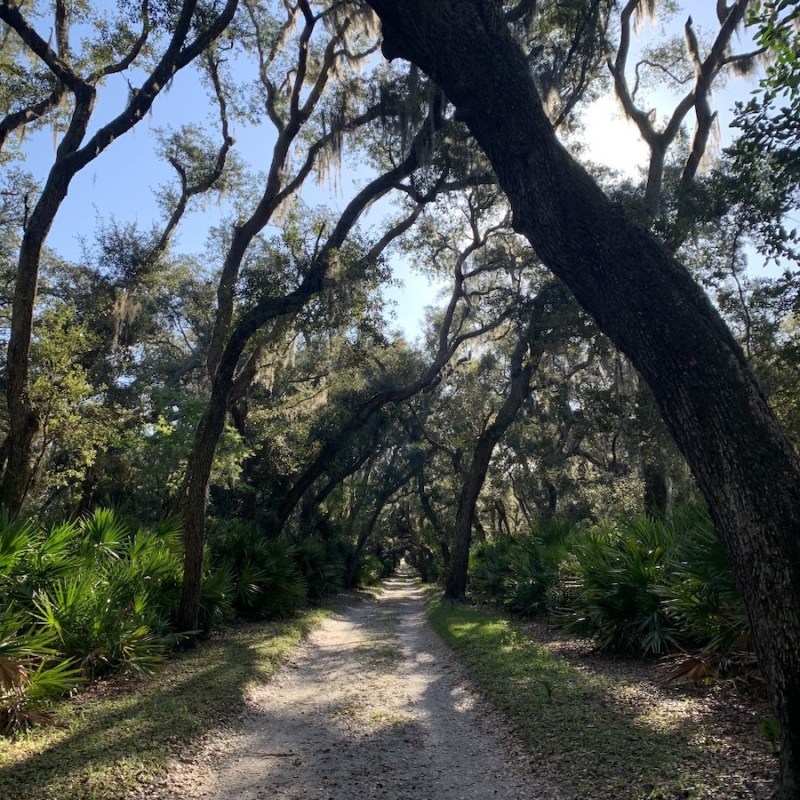
Emily Schmidt
You will not need to change your watch or cross time zones when taking a ferry to Cumberland Island. But don’t be surprised if the 45-minute boat ride to Georgia’s southernmost and largest barrier island somehow transports you to another time and place where horses run wild, ocean beaches stretch for miles, and history waits for you to discover it.
Videos by TravelAwaits
Generations of the Carnegie family knew this place is special. So did John F. Kennedy, Jr. and Carolyn Bessette, who chose to get married at a small church on the island’s north end.
Spend a few hours or be lucky enough to spend three days here like I did with my family, and you’ll know it’s special, too. Here are eight ways to fall in love with Cumberland Island National Seashore which lets you #findyourpark — and peace and quiet — at the same time.
1. First Thing’s First: Get Your Cumberland Island Ferry Ticket
This is an important first step. Only about 300 visitors each day can take the passenger ferry service to the island. That means you should make a reservation as soon as you plan your trip, and the ferry schedule will dictate your time. You will depart from the visitor center in St. Marys, Georgia, which is about seven miles away from the island. St Marys has restaurants with outdoor seating and waterfront views where you can grab an early breakfast or late dinner.
Pro Tip: Pack wisely. There are no stores on the island, so you need to carry everything you will need while there. Don’t forget bug spray, layers of clothing, sunscreen, food, and a water bottle; you can refill water at a few sites.
2. Ride A Bike Or Take A Tour
You can bring your own bike on the ferry for a fee or rent carts and bikes by the Sea Camp Ranger Station. It is a way to tour under a canopy of live oaks covered with Spanish moss, and you might catch yourself feeling like you are riding through a movie set.
Pro Tip:All roads are sand. Getting from one place to another is beautiful but takes more energy than a ride through a suburban neighborhood. If you are on a day trip, you also need to plan your trip to coincide with the return ferry. Downshift your distance expectations and enjoy the resulting ride.
Another important note: The National Park Service says all-terrain, non-motorized beach wheelchairs better suited for the terrain are available in limited numbers for use on the island. Mention if you need one when making your ferry reservations so you know one will be available for you.
If biking doesn’t sound like a day at the beach, there is a group tour option available from the same company that sells the ferry tickets. You will not see all of the island, but you will spend 5 to 6 hours getting a feel for much more than you could see on your own.

Emily Schmidt
3. Go Wild For Horses
Chances are, some of your photos of Cumberland Island will include four-legged photobombers. The National Park Service says it counts about 120 to 148 feral horses on the island. You will see them grazing along salt marshes, running on the beach, or at some of the park sites. They seem unphased by tourists, yet they are not tame; keep your distance when looking for the perfect shot. The National Park Service recommends staying 50 feet away and remembering the animals have the right of way.
4. Hit The Cumberland Island National Seashore Beach
I’ve visited Atlantic Ocean beaches stretching from Maine to Key West and never experienced undeveloped beaches like the 17 miles you will find on Cumberland Island. Sand dunes are high, beaches wide, and crowds almost non-existent. Throw out a towel, listen to the waves, and keep your eyes peeled for pods of dolphins and sea turtles.
Pro Tip: Swimming is allowed but there are no lifeguards.

Emily Schmidt
5. Explore One Mansion And The Ruins Of Another
Indigenous people settled on Cumberland Island as many as 4,000 years ago, and some of the fences around buildings are made of shells taken from mounds piled up by those earliest residents. The Spanish, then English, lived on the island throughout later centuries, and Cumberland Island’s residents included communities of enslaved people as well.
In the 1880s, new arrivals transformed the island as family members of American industrialist Andrew Carnegie discovered Cumberland Island. At one point, they owned 90 percent of the land before giving it to the federal government to create the Cumberland Island National Seashore in 1972.
Today, you can get a glimpse of what it was like to live as a Carnegie. The 22,000-square-foot Plum Orchard Mansion is open for free guided tours. The National Park Service suggests allotting 3 to 5 hours roundtrip to bike there from the Sea Camp ferry dock. The reward for getting there is walking through what it must have felt like to spend Georgian summers in luxury.
A 2.5-mile round-trip hike has a big payoff as well: the ruins of Lucy Carnegie’s Dungeness mansion. The mansion was as big as 35,000 square feet before it burned in 1959. Legend says poachers who were upset they could not hunt there set the fire. Whatever the cause, the remains of the stone and brick walls are majestic and perfect for photographs, and you can tour other nearby buildings that give you an idea of how many people it took to run such a grand estate. There are picnic tables and restrooms nearby, making this a great place for lunch and sightseeing.

Emily Schmidt
6. Take A Photo At A Wedding-Famous Spot
If Cumberland Island sounds familiar but you are not exactly sure why, here’s the likely answer: On a September evening in 1996, JFK Jr. and Carolyn Bessette, seeking a way to get married with no paparazzi in sight, exchanged vows in the island’s one-room First African Baptist Church. Photographer Denis Reggie documented the event, and his photo of the couple walking out the church doors is now part of the Smithsonian National Museum of American History’s permanent collection in Washington, D.C.
You can take the same Lands and Legacies tour that goes to Plum Orchard Mansion to see the church for yourself.
Though there are no signs of the famous wedding, it’s still worth the trip. Step inside the open church and you’ll see the painted windows and narrow wooden pews in place for the African American island residents who founded the church in the late 1890s and rebuilt it four decades later. It is a glimpse into the challenges of life for people of color on the island over the past centuries.
7. Rough It
Unless you are one of the very few residents who owns property on Cumberland Island, there are only two ways to stay there if one day is just not enough. One: You can get a permit to camp. There are no cabins, you need to be prepared to hike your gear to the sites, and only one of the campgrounds has drinkable water. The upside: You can sleep knowing you are nearly alone in the quiet, and your company is most likely to be an armadillo scampering through the palmettos.

Emily Schmidt
8. Or Don’t Rough it
Armadillos too much? Many people say their bucket-list way to stay on Cumberland Island is to make a reservation at the all-inclusive, private Greyfield Inn, which is still run by the Carnegie family. Staying there is literally a different way to experience the island from the start. Instead of leaving on the public ferry from Georgia, guests board a private ferry called the Lucy R. Ferguson from Fernandina Beach, Florida, which is just over the Florida-Georgia state line.
Luggage is limited to two bags per person, and you may need to pack a bit more than usual, as you could spend the day biking, kayaking, or on the beach, and then dress up for dinner, which the Greyfield Inn calls a “casual, elegant affair.” Food is locally sourced; you can tour the garden where much of it is grown and buy a cookbook by the Inn’s chef, Whitney Otawka, to bring a bit of island flavor home.
When you are here, do not count on Wi-Fi to connect with the outside world. Instead, read a book from the library on the incredibly wide porch swings, browse a small jewelry gallery with nature-inspired creations by Gogo Ferguson, or enjoy happy hour cocktails curated to match the era of the grand home. We took a tour while sitting in a pickup truck bed outfitted with wooden benches; be prepared to listen when the naturalist yells “Duck!” when driving down the bumpy yet beautiful road.
I left with amazing memories and new fellow-traveling friends; those who seek out Cumberland Island tend to have similar loves of conservation, adventure, and history.
No matter how you visit, any time on Cumberland Island National Seashore is time to be savored, feeling as if you are among the first to discover a special place.
